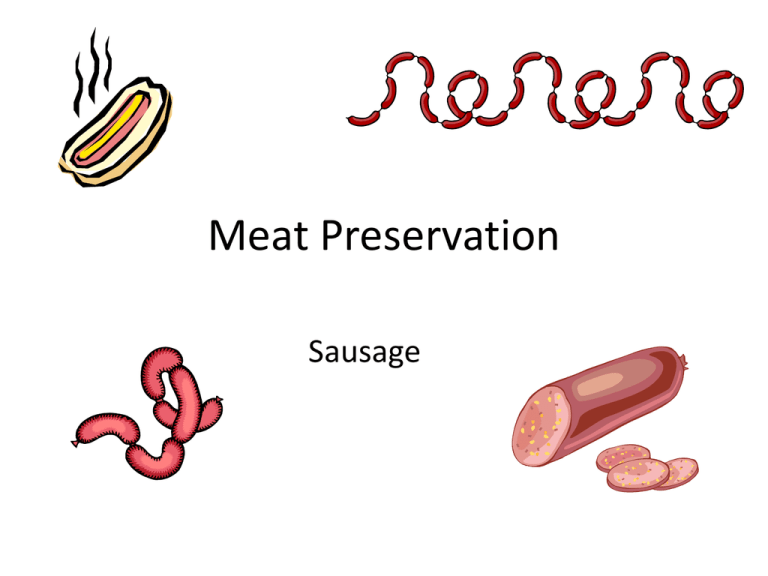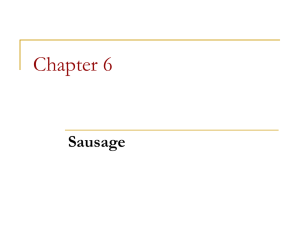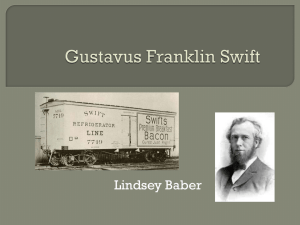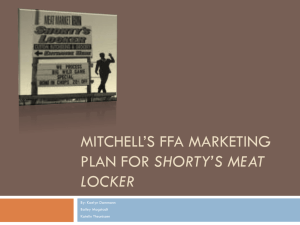Top Dinner Sausage Consuming Cities – 2009 1.
advertisement

Meat Preservation Sausage What is a Sausage? • Word sausage is from word Salsus – Salsus means salt or preserved • Is a chopped or comminuted and seasoned meats that is formed into a symmetrical shape • Can contain non-meat ingredients History of Sausage • Reason for discovery of America and trade with Asia • Used to be “Bags of Mystery” – Historically were made from by-products and left-overs • Modern sausage is made from lean trimmings or low value whole muscle cuts – Skeletal muscle, Cheek, jowl, and head meat from beef pork and poultry Sausage Varieties Consumption of Sausage Top Dinner Sausage Consuming Cities – 2009 • • • • • • • • • • • 1. Los Angeles 2. New York 3. San Antonio/Corpus Christi 4. Houston 5. Baltimore/Washington, D.C. 6. Chicago 7. Dallas/Fort Worth 8. South Carolina 9. San Francisco/Oakland 10. Philadelphia Source: Information Resources Inc. Based on total retail sales, excluding Wal-Mart, for the 2009 calendar year. – National Hot Dog & Sausage Council Classifications • Degree of grinding or chopping – Coarse ground vs. emulsion or fine chop • Amount of cooking – Cooked vs. uncooked • Amount of smoke – Smoked vs. non-smoked • Amount of water added – Water added vs. no water added Classifications • Amount of curing – Cured vs. not cured • Amount of fermentation – Fermented vs. non-fermented • Amount of tissue moisture • • • • • • Fresh: non-smoked and uncooked Smoked: fresh and cured Cooked: fresh and cured smoked and non-smoked Cured: smoked and non-smoked Dried: semidry and dry Meat loaves and specialty items USDA Classifications 1. 2. 3. 4. 5. 6. Fresh Uncooked smoked Cooked and smoked Cooked Dry and semidry Luncheon meat, loaves and jellied 1. Fresh • Fresh, uncured meats used – ≤ 3.5 % binders and extenders allowed – ≤ 50 % fat – ≤ 3 % water/ice • Pork, beef, and most recently chicken • Must be refrigerated and thoroughly cooked 1. Fresh • Breakfast sausage • Whole hog sausage – Prepared from fresh/frozen meat from pig in such proportions as are present in a single animal 1. Fresh • Italian Sausage – Uncured, non-smoked sausage – 85 % of formula must be meat and fat – ≤ 35 % fat – ≤ 3 % water/ice – Salt, pepper, fennel and anise used – If labeled as “Italian Sausage” must contain only pork • Any other species must be indicated on label “Chicken Italian Sausage” 2. Uncooked Smoked • Same types of products as fresh, but smoked for color and flavor • Must be cooked before consumption • Includes: fresh smoked pork sausage – Same as fresh pork but smoked • Fresh smoked kielbasa – Highly seasoned Czech sausage – Coarse ground pork with beef or mutton added – Smoked but not cooked 3. Cooked and Smoked • Frankfurter, bologna, knockwurst, and similar products – Comminuted, semisolid – One or more kinds of raw skeletal meat and poultry meat – ≤ 35 % fat – ≤ 10 % added water – Smoked or non-smoked – ≤ 15 % raw or cooked poultry meat – Can contain by-product and variety meats – ≤ 15 % partially defatted pork or beef fatty tissue 4. Cooked • Liver sausage and Braunshweiger – Fresh/frozen pork and/or beef trim – Pork liver or beef liver or veal liver or combination – Can contain: beef/pork by-products, pork skin, sheep liver, goat liver if labeled – Must be at least 30 % liver – Cooked 5. Dry and Semidry • Produced by fermentation – Fermentation-conversion of sugar -> lactic acid – Backslopping – Lactic acid starter culture • • • • Lowers pH Preserves Inhibits growth of spoilage bacteria Provides characteristic tangy flavor – Fermentation chamber – Dried carefully: smoked sometimes 5. Dry and Semidry • Semidry (Summer sausages) – Fully cooked in smokehouse – Semi-soft due to bacterial fermentation – < 50 % moisture content • Dry (Salami) – Light smoke, if any – Drier, firmer, more expensive – < 35 % moisture content 6. Lunch meat, loaves, jellied • Various products • Luncheon meat – Cured and cooked – Comminuted meats – ≤ 3 % water/ice • Meat loaf – Loaf shaped comminuted meat • Scrapple – Must contain at least 40 % meat and/or meat products on fresh weight basis – Cereal and/or soybean flour or meal allowed 6. Lunch meat, loaves, jellied • Bockwurst – Uncured – Cooked or uncooked – Meat, milk or water, and may contain eggs and vegetables – Must be at least 70 % meat – Usually pork 6. Luncheon meats, loaves, jellied • Head Cheese – Mixture of meats held together by a gelatin – Used in salads, sandwiches and as hors d’oeuvres Sausage Ingredients Sausage Ingredients • Animal Tissues– A. Meat – skeletal muscle (trimmings) beef, pork, poultry etc. – B. Meat by-products or variety meats (Non-skeletal, smooth muscle-tongues, lips, tripe, etc.) • Most high quality sausage are void of by-products • Water (moisture) – Usually in the form of ice – Helps cool product (avoids friction) and adds weight Why are sows used for Sausage? Sausage Ingredients • Curing Ingredients – – – – A. Salt B. Spices – plant leaves, seeds, stems or roots C. Flavorings – man made D. Color developers – nitrites, ascorbates • Sweeteners – Non meat ingredients • Sugars, honey, etc. Spices • Regional Sausages – Many sausages are regional because that is where spice is grown – Even with trade, spice regions produce the best sausage • Spice trades – Reason for discovery of Asia and America Spices Product Spice Breakfast Sausage Sage Italian Sausage Fennel Polish Sausage Garlic Bratwurst Onions Color Enhancement Paprika Sausage Ingredients • • Binder and Fillers – A. Binder – Binds water and helps emulsify – B. Filler – Binds water, lowers costs (decreases meat contents) – C. These products are usually (soy, cereals, and milk proteins) Binders/Extenders – Hold meat together and allow it to form • Starch • Soy • Collagen • Onions • Rice • Skin • Phosphates • Non-Fat Dried Milk Sausage Casings • Casing determines shape of sausage • Natural Casings – Made from stomachs, intestines and bladders – Mostly from pigs and sheep • Manufactured/Artificial – Made from cotton linters, paper pulp and beef hides Sausage Formulation Meat Properties for Sausages • Binding Index – Relative amount of salt soluble, heat coagulable protein (SSHCP) – Bull meat has an arbitrary BI set at 100 • Color Index – Measures the relative amount of myoglobin – Bull meats CI set at 100 • Moisture: Protein Ratio – Moisture,% / Protein, % Salt Soluble Heat-Coagulable Proteins (SSHCP) • Proteins with polar and non-polar properties – Actin and Myosin – Polar region attracted to water – Non-polar region attracted to fat • Help to emulsify fat and water – Bologna, hot dogs are true emulsions – Emulsion = mixture of two immiscible liquids (water and oil/fat) • Extracted from muscle tissue by salt, chopping , and mixing • Heat-coagulable – Harden to form a matrix during heating cycle Emulsification • Fat = dispersed phase • Water = continuous phase • Solublilized proteins associate with fat and water Target Fat % • Desired fat % can be achieved by mixing of two sources • Sausage Makers Square Innovation • Blueberry sausage – Fresh breakfast sausage – Includes whole ground blueberries • Adds sweetness • Reduces fat content • Adds ingredient rich in antioxidants Product Development • Select type of sausage – Fresh, dry, semi-dry, cooked, cooked smoked, uncooked, lunch meat • Select ingredients – Salt, sugar, nitrites, spices…. • Select 2 meat sources 70:30 Beef Trim 50:50 Pork Trim 80:20 Beef Trim 75:25 Pork Trim 90:10 Beef Trim Exotic (Deere, Elk, etc) Trim at 93:7 85:15 Lamb Trim 90:10 Lamb Trim Sausage processing Grinding Coarse Grind • Whole muscle pieces or trim • Meat chunks of variable shape and fat content are ground to from uniform cylinders of fat and lean Mixing • Fat and lean cylinders are tumbled in a mixer to give uniform distribution of fat and lean particles •Mixing also aids in extraction and coating of fat particles with salt soluble proteins Chopping or Fine Grinding • Chopping – Used for greater particle size reduction and greater degree of emulsification Chopping or Fine Grinding • Fine Grinding – Fine grinding plate Stuffing • Stuffers extrude sausage emulsion into casings Linking and tying • Tying occurs via thread, string, or metal clips • Linking can occur mechanically or by hand twisting or drawn by string • Large items are tied or clipped with a hanging tie for suspension from smoking rod • Commercial frank machines can stuff and link 600 to 3600 lbs per hour Smoking and Cooking • Smoke house performance depends on – Dimension – Time cycle – Temperature range – Thermal requirements (BTU) – Relative humidity – Air flow – Air flow pattern – Smoke Density Chilling • Product can be chilled by refrigeration or cold water shower • Large volume operations using using continuous systems will rely on a brine chilling solution applied by dipping or spraying Sausage Defects Gelatin Pocket or Fat Cap • Problem with emulsion formulation or imbalance of myosin and collagen (Too low content of lean meat in formula) • May also be result of too rapid heating or too high temp during cooking Too much connective tissue Ground To Fine THE END










